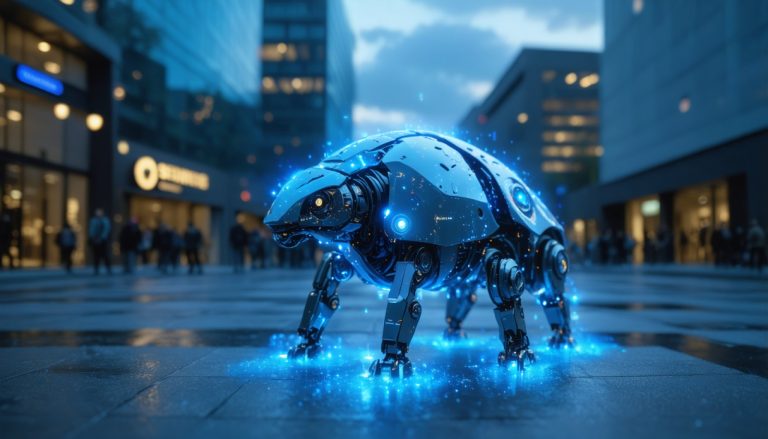
- ATU students and faculty showcased innovative research at the 2025 Arkansas Space Grant Consortium Symposium on Petit Jean Mountain.
- A groundbreaking installation on Hybrid PV-TEG and PV-PCM Solar Systems presented a leap in solar efficiency, promising cleaner energy solutions.
- Zachary Jimerson’s dipole antenna, part of the Radio JOVE Project, aimed to investigate atmospheric activities via ionosphere fluctuations.
- A teleoperable tendon-driven robotic hand demonstrated new possibilities in medical robotics and remote exploration.
- Machine learning was utilized in anomaly detection for hydrogen fuel cells, enhancing reliability and efficiency in green technology.
- The symposium highlighted ATU’s dedication to cutting-edge research and the power of cross-disciplinary collaboration.
- Keynote speeches emphasized the role of robotic innovation in driving future progress.
- The event celebrated the nexus of academia and innovation as a catalyst for solving global challenges.
Amidst the breathtaking scenery of Petit Jean Mountain, Arkansas Tech University (ATU) students and faculty electrified the 2025 Arkansas Space Grant Consortium Symposium with groundbreaking research that pushes the boundaries of technology and innovation.
Against the backdrop of Winthrop Rockefeller Institute, the atmosphere vibrated with the excitement of fresh ideas and pioneering spirit. The symposium proved to be an intellectual feast, spotlighting brilliant minds who are crafting the future one experiment at a time. Guided by esteemed mentors, a cohort of ambitious ATU researchers unveiled a series of fascinating projects, each echoing a promise of technological advancement.
Kicking off the symposium, the installation exploring the performance of Hybrid PV-TEG and PV-PCM Solar Systems captivated the audience, merging photovoltaic and thermoelectric generator technologies with phase-change materials. This collaboration suggested a leap in solar efficiency, elegantly presented by Joseph Dockery and his team. Their work, overseen by Dr. Zahra Zamanipour and Dr. Seyed Ehsan Hosseini, proposes a cleaner, more efficient solar energy, casting sunlight as a viable solution to our planet’s energy woes.
On the cosmic side of exploration, Zachary Jimerson captivated attendees with his intricate work on a dipole antenna designed to eavesdrop on the universe. Through the Radio JOVE Project, supervised by Dr. Matthew Hankins, this ingenious contraption aims to decode the mysterious whispers of ionosphere fluctuations, offering insights into the atmospheric activities that have long puzzled scientists.
In a stunning display of mechanical mastery, another team of budding engineers—Zachary Giese, Avery Mahan, Joseph Gober, Samuel Grisham, Aspen White, and Brayden May—revealed a meticulously crafted teleoperable tendon-driven robotic hand. Mentored by Dr. Zamanipour and Dr. Mohammad Amjadi, this innovation exemplifies the harmonious blend of human dexterity and robotic precision. It holds the potential to revolutionize everything from medical robotics to remote exploration.
Exploring the realm of green technology, Benjamin Leon, Dillon Wood, and Ethan Mashburn presented on the vital role of Machine Learning in Anomaly Detection for Hydrogen Fuel Cells. Their pioneering work, under the guidance of Dr. Afsana Ahamed and Dr. Hosseini, leverages artificial intelligence to enhance reliability and efficiency, signaling a smarter, more sustainable future for energy systems.
These presentations not only underscored ATU’s commitment to cutting-edge research but also demonstrated the potential of cross-disciplinary collaboration in solving complex global challenges. As these young scholars left the symposium, they carried with them the delights of knowledge and the empowerment to transform ideas into reality.
Wrapping the day, insights from keynote speaker Johannes Starks heralded a future where robotic innovation fuels progress, a vision shared by student keynote Jack Seabaugh, who brought stories of pioneering NASA experiences back to Arkansas.
The symposium stands as a testament to the inspiring confluence of academia and innovation—a vibrant reminder that in the race to solve global challenges, the next great leap may just begin with the spark of curiosity ignited in an Arkansas classroom.
Unveiling Tomorrow’s Technology: How ATU’s Pioneering Research At The Arkansas Symposium Could Change Our World
Introduction
Arkansas Tech University’s (ATU) presentation at the 2025 Arkansas Space Grant Consortium Symposium was a testament to the fusion of ingenuity and academia. This article delves into the finer details of their breakthrough projects and explores the broader implications of such advancements.
Exploring Hybrid Solar Systems: Increased Efficiency and Clean Energy
Joseph Dockery and his team’s investigation into Hybrid PV-TEG and PV-PCM Solar Systems represents a significant step towards enhanced solar energy efficiency. By integrating photovoltaic and thermoelectric generator technologies with phase-change materials, these systems can capture and store more energy than traditional methods.
How-To Steps for Implementing Hybrid Solar Systems:
1. Assess Your Environment: Ensure the availability of adequate sunlight.
2. Select Appropriate Technology: Choose between hybrid PV-TEG, PV-PCM, or a combination of both based on energy needs and environmental conditions.
3. Install Efficiently: Consider both professional installation and DIY methods, keeping costs and expertise in mind.
Real-World Use Cases: Residential energy generation, off-grid applications, and sustainable urban planning.
Market Forecasts & Industry Trends: With a growing emphasis on renewable energy, the hybrid solar market is projected to expand significantly, potentially reaching billions in market value by 2030, according to [CNET](https://www.cnet.com).
Decoding the Universe: Cosmic Discoveries with Dipole Antennas
Zachary Jimerson’s project explores the mysteries of the ionosphere through a dipole antenna as part of the Radio JOVE Project. By capturing radio emissions from celestial bodies, it provides critical information about atmospheric conditions.
Applications: Enhance satellite communications, improve weather prediction models, and contribute to space exploration endeavors.
Revolutionizing Robotics: The Teleoperable Tendon-Driven Robotic Hand
The team of Zachary Giese, Avery Mahan, Joseph Gober, Samuel Grisham, Aspen White, and Brayden May presented an innovative teleoperable tendon-driven robotic hand. This provides precise, human-like motion through remote control, offering substantial benefits for fields such as healthcare and manufacturing automation.
Security & Sustainability: With an increasing emphasis on secure coding practices and AI ethics, enhanced robotic systems need to focus on secure data handling and sustainable manufacturing practices.
Pros & Cons Overview:
– Pros: High precision, potential cost reduction in surgeries, and advanced mobility in prosthetics.
– Cons: High initial cost and technical skills requirement for operation.
Harnessing Machine Learning for Sustainable Energy
Benjamin Leon, Dillon Wood, and Ethan Mashburn’s work on Machine Learning in Anomaly Detection for Hydrogen Fuel Cells exemplifies the shift towards smarter, cleaner energy systems. By using AI to predict and prevent system failures, this research significantly enhances the reliability of hydrogen fuel technology.
Features, Specs & Pricing: As AI and machine learning tools become more accessible, integrating them into energy systems will decrease costs and improve performance.
Keynote Insights: Future of Robotics and Space Exploration
Concluding with insights from keynote speakers, the event underlined the potential of robotic innovation in fueling progress across various sectors. The narratives shared by student keynote Jack Seabaugh enriched the discourse with firsthand NASA experiences.
Actionable Recommendations
– Stay Informed: Regularly update yourself on technological advancements and energy solutions.
– Consider Sustainability: Implement sustainable practices in personal and professional settings.
– Embrace Cross-Disciplinary Approaches: Collaboration across fields can lead to innovative solutions.
CNET offers further insights into the latest technological trends that can help incorporate these solutions into daily life.
Conclusion
As showcased by Arkansas Tech University, the blend of innovation, technology, and academia is poised to drive future solutions to global challenges, signaling a brighter, more sustainable future fueled by curiosity and collaboration.



